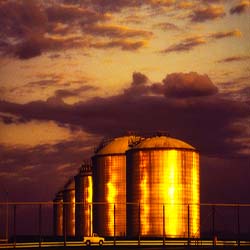The 1970s was a decade of high oil prices. In response to the conflicts in the Middle East, OPEC reduced their petroleum production and created an embargo on oil shipments to the United States. In the three months after the embargo was announced, the price of oil spiked from $3 per barrel to $12. After years of plentiful supply and increased consumption, the U.S. now faced price spikes and shortages, with lines subsequently forming at gas stations around the U.S.
Leaders across the country called for conservation of energy by asking gas stations to close on weekends and other measures. The energy crisis also was devastating to the U.S. car industry. American car manufacturers had been building large and larger cars which were now suddenly less appealing than smaller more fuel efficient foreign cars.
Even though the oil embargo was lifted in early 1974, oil prices remained high and the effects of the energy crisis remained for the rest of the decade. As a result of the spike, non OPEC oil production surged in places like China, Oman, North Sea, Mexico, and the U.S.
By 1986 a huge amount of excess oil had stockpiled and prices collapsed; between November 1985 and March 1986 oil prices fell by over 65 percent and the price of a barrel of oil fell from $30/barrel to nearly $10, essentially halting the U.S. oil industry. In late 1985, there were over 2,000 rigs in the U.S. and a year later, that number declined by 50 percent. There was a glut of oil in the U.S.
How is this decline different from the 1980s?
1) The dollar strengthened in the 1980s as the Federal Reserve fought inflation, and then in agreement with other large economic powers, the U.S. currency was devalued. The USD lost 40 percent of its value between March 1985 and December 1987. That stands in contrast to today: The dollar is strong and has strengthened against almost every currency
2) The development of fracking and other technologies have made previously unprofitable reserves suddenly profitable.
3) The melt-down of 2008 reduced the growth rate globally and oil demand with it.
4) Economies in U.S. oil centers such as Houston are substantially more diversified than the 1980s.
So how long did it take oil to recover?
About 20 years. Only recovering slightly with the Gulf War it took nearly two decades before "low prices” was the cure for “low prices.” It wasn’t until around 2000 did prices recover when supply couldn’t keep up with the rising demand from as a result of global economic growth mainly from Asia.






